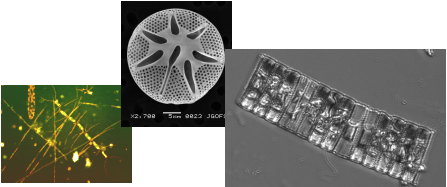Southern Ocean Carbon Cycle:
Ocean Carbon Cycle Studies off Antarctica
Overview
The Southern Ocean is defined as those waters south of 40 degrees south, representing 20% of the world's ocean area and truly a unique ocean setting. Ice sheets covering an area as large as the Antarctic continent form a solid cover that melts back every spring to its southern boundaries and the permanently ice covered coastal regions. Water temperatures range as low as minus 1.8 degrees Celsius, near the freezing point of salt water. Invisible boundaries defined by ocean currents and water properties within the circumpolar currents separate the Southern Ocean in to bands of separate biological and geochemical provinces surrounding Antarctica. It is in these harsh and remote conditions that we have been studying the ocean carbon cycle.

What's it like at the bottom of the Earth?
Read Ken's letters home describing his experiences working on the far edge of the world and what it is like to be on a research cruise from Australia to Antarctica. Letters Home
Selected Scientific Publications
Buesseler, K.O., Barber, R.T., Dickson, M-L, Hiscock, M.R., Moore, J.K., and R. Sambrotto (2002). The effect of marginal ice-edge dynamics on production and export in the Southern Ocean along 170ºW (PDF). Deep Sea Research II, 50, 579-602.
Buesseler, K.O., L. Ball, J. Andrews, J. K. Cochran, D. J. Hirschberg, M. P. Bacon, A. Fleer and M. Brzezinski (2001). Upper ocean export of particulate organic carbon and biogenic silica in the Southern Ocean along 170°W (PDF). Deep Sea Research II, 48, 4275-4297.
Nelson, D.M., R.F. Anderson, R.T. Barber, M.A. Brzezinski, K.O. Buesseler, Z. Chase, R.W. Collier, M.-L. Dickson, R.François, M. Hiscock, S. Honjo, J. Marra, W.R. Martin, R.N. Sambrotto, F.L. Sayles and D.E. Sigmon. 2002. Vertical budgets for organic carbon and biogenic silica in the Pacific sector of the Southern Ocean (PDF), 1996-1998. Deep-Sea Research Part II, 49 (9-10), 1,645-1,673.
Cochran, J. K, K. O. Buesseler, M. P. Bacon, H. W. Wang, D. J. Hirschberg, L. Ball, J. Andrews, G. Crossin and A. Fleer (2000). Short-lived thorium isotopes (234Th, 228Th) as indicators of POC export and particle cycling in the Ross Sea, Southern Ocean (PDF). Deep-Sea Research II., 47 (15-16), 3451-3490.
Conference Presentations
"Melting ice, primary production, and particle export in the Southern Ocean—What's the connection?" (PDF)
